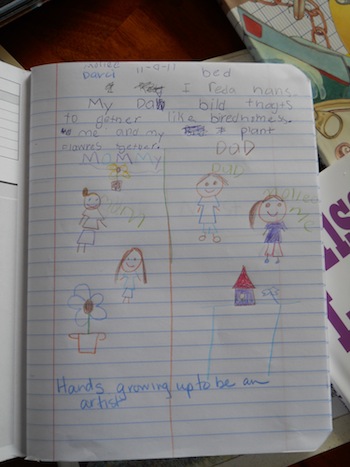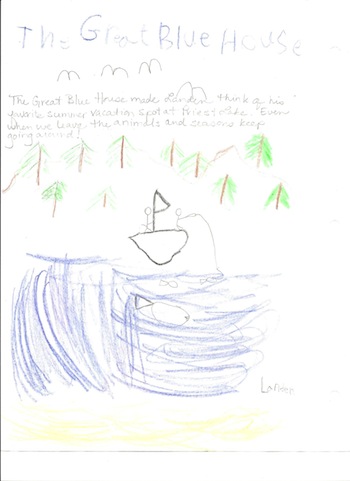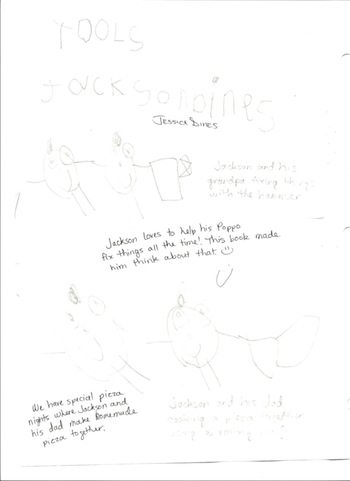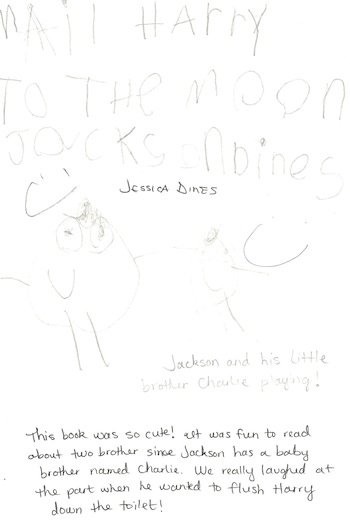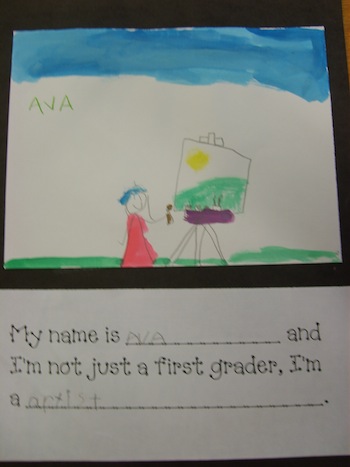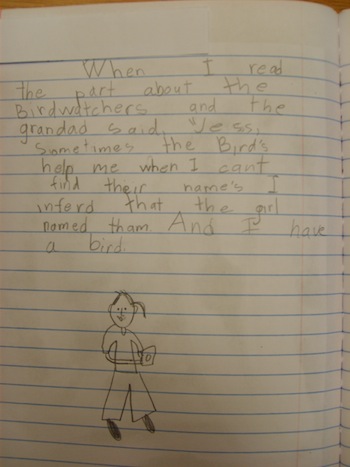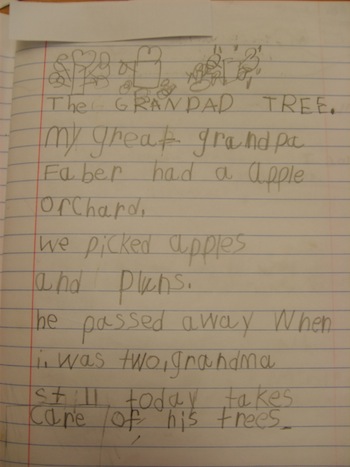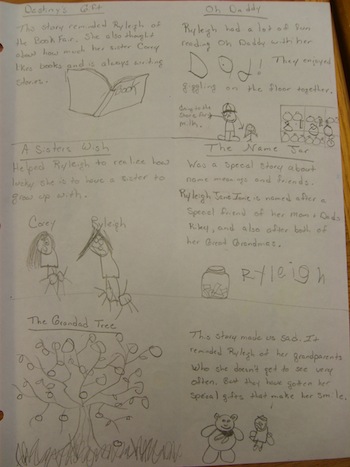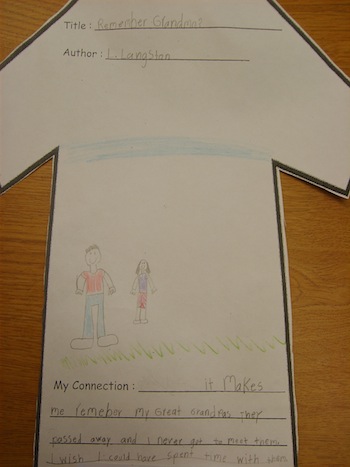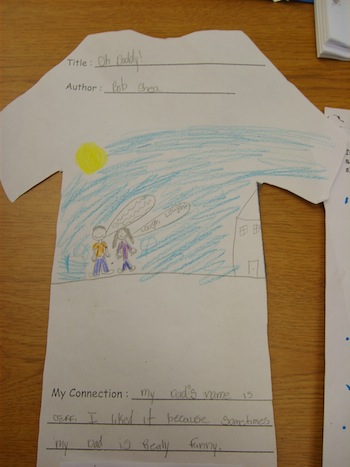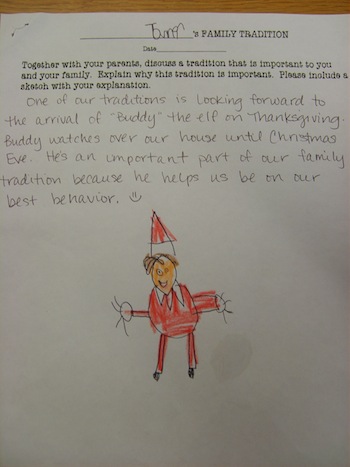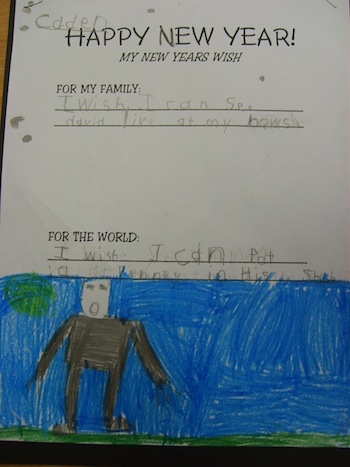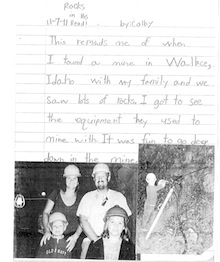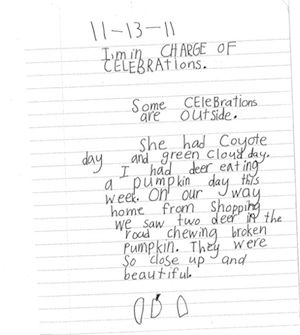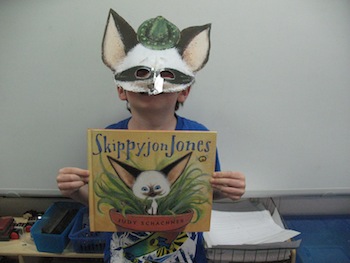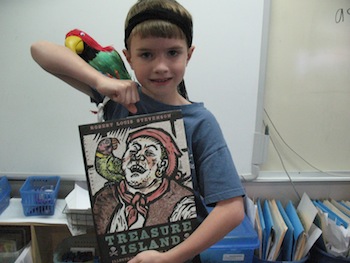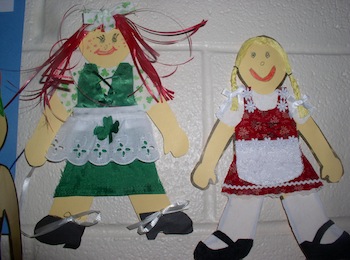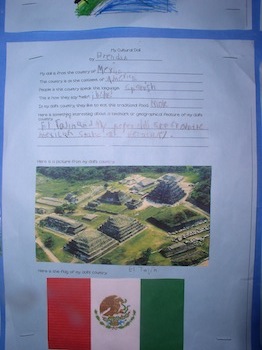Exploring Cultures in Primary Classrooms
Marilyn Carpenter and the Spokane Literacy Community
Our literacy community started the school year in September with an after school meeting in Abby Spencer’s classroom. Our gathering included me and seven primary teachers representing three school districts in the Spokane, Washington area. We had worked together as a literacy community the previous year and planned that our main goal this year would be to share an abundance of global literature with our students through read alouds, text set explorations and independent reading. Our second goal was to collaboratively support each other in this focus. One of the ways we did this was to schedule our monthly meetings in different members’ classrooms. It was helpful to see examples of the curriculum we were exploring. Observing our colleagues’ bulletin boards, class books, students’ journals provided inspiration. Abby sparked our first meeting by sharing some of the books that she already had read aloud to her class.
Our third goal was to base our study group meetings and the design of the students’ explorations of global literature on the curriculum framework in “Curriculum that is International” (Short, 2007). Our plan was to spend two months on each part of the framework. In our classrooms we began by sharing children’s literature that promoted responses regarding personal cultural identities, the center of this curriculum framework. Then we planned to proceed through the curriculum framework, ending with inquires into global issues. We intended that the last part of our curriculum would be to guide our students to take actions based on their exploration of global issues.
At our September meeting, we read “The Curricula of Sharing Family Stories” (Fimbres, 2011). Gabrielle Fimbres described how the University of Arizona’s College of Education worked closely with the Flowing Wells Unified School District to develop a pilot program to encourage students’ families to share their own stories. Backpacks were sent home with children’s books centered about a theme. Families were invited to record their own stories in a journal or on a digital recorder. Fimbres’ article prompted a discussion of how we could do a similar project to encourage our students’ explorations of personal cultural identities through the sharing of family stories. We decided to lengthen the time for this study to complete what we called the “Family Story Book Bags” project. When we decided to adopt the Family Story Book Bag project, it meant a change in the means of accomplishing our goal regarding personal cultural identities. Therefore we spent two more months than planned on exploring personal cultural identities. In our meeting we collaborated on how we would present the Family Story Book Bag project in our classrooms. The majority of this vignette will focus on that one part of our curriculum that was common to each classroom, the Family Story Book Bags, with specific examples from Melissa Carpenter’s second grade classroom.
First, we developed a letter that would go home to parents a week prior to the start of the project describing the “Family Story Book Bags.” Here is a sample letter that went home in Melissa’s classroom:
Dear Families,
During the next few months our class will engage in a literacy activity called Family Story Book Bags. These book bags contain children’s books to share and enjoy at home—and most of all to inspire you to tell your own stories as a family. The books included in the book bags will explore topics important to families, such as Relationships, Celebrations, Foods, Heritage, Hobbies and Play. The purpose of this literacy project is to provide a springboard for sharing family stories as a way for children to learn about their own culture.
Here is how it works. Each week, five children from the classroom will bring home one of the Family Story Book Bags. Each book bag has a selection of books centered on familiar family topics. When your child brings home a book bag, your family will have one week to read and enjoy the books and to write and/or draw your responses and family stories in the journal. Since each family is different, each response will be unique as well. As you enter your responses in the journal, please include the title of the book, your child’s name, and your name(s) at the beginning of the response. Please note that Nightly Reading and Math homework will not be required of your child during the week you have a Family Story Book Bag. The books in the book bag and the journal entries you and your family complete will take the place of regular homework.
When you return the book bag another student will be able to take it home. In this way all students will have been able to take home a book bag before the winter break when we wrap up our social studies unit on personal culture.
When each child has had an opportunity to take home the book bag and return it, we will share the journal responses in class. In this way, we will be able to learn about each other and our families and how our personal culture is formed in our family.
Have fun with the books and be as creative as you like with the responses. Thank you for your support and enthusiasm.
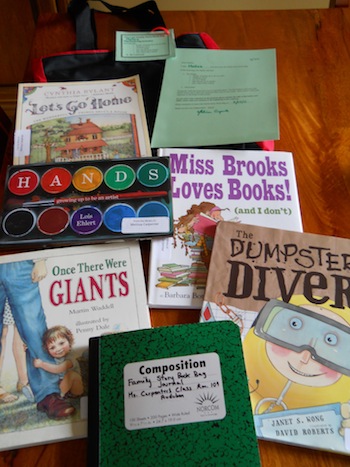 Each class had four or five bags to send home depending on the class size. Charlotte Streit and Meg Baker had a supply of bags from our local teachers’ credit union that they shared with the other teachers. In Melissa’s classroom each week five bags went home on Mondays to be returned on the following Monday.
Each class had four or five bags to send home depending on the class size. Charlotte Streit and Meg Baker had a supply of bags from our local teachers’ credit union that they shared with the other teachers. In Melissa’s classroom each week five bags went home on Mondays to be returned on the following Monday.
Each bag featured five books that connected with personal culture. A laminated tag attached to the outside of the bag listed the titles inside the bag. The backside of the tag featured the logo of the school and her room number.
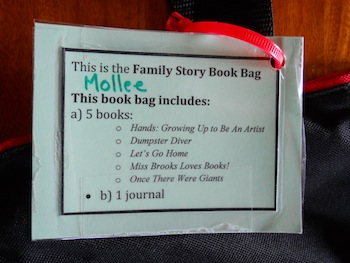
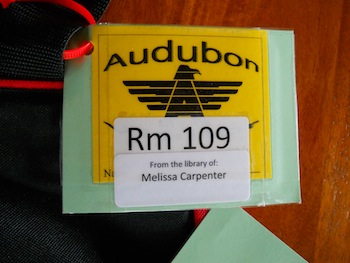 The teachers thoughtfully selected the books in the bags (download the list of books that were used in the book bags here). The teachers decided on similar categories for the books the bags to encourage family stories. Melissa used these categories to organize the books in the bags she sent home:
The teachers thoughtfully selected the books in the bags (download the list of books that were used in the book bags here). The teachers decided on similar categories for the books the bags to encourage family stories. Melissa used these categories to organize the books in the bags she sent home:
•Favorite family foods;
•Games/play;
•Family Structures;
•Heritage;
•Everyday life including hobbies, music, etc.
A journal to record family stories in a written or graphic way was placed in each bag together with a laminated letter to parents. Here is a template of Melissa’s letter:
Dear Families,
Today _____________________ will take home the Family Story Book Bag.
In this book bag your family will find:
•Five books
Alex and the Wednesday Chess Club
Clouds for Dinner
Music, Music for Everyone
The Visit
Wink
•One journal
During the week the books are yours to read and enjoy. Use the books to tell your own family stories and to share the memories that come to your mind. Draw and/or write your responses to the books in the journal.
As you enter your responses in the journal, please include the title of the book, your child’s name, and your name(s) at the beginning of the response.
Please remember to return the Family Story Book Bag on _____________________
Thank you for your collaboration. Enjoy!
The journals were a hit with the families as they responded to the book they read together from the bags and described their own family stories. One of Melissa’s students wrote and illustrated a response to Hands: Growing Up to Be An Artist (Ehlert, 2004), saying, “I read Hands. My dad builds things together like birdhomes. Me and my Mom plant flowers together.” Dumpster Diver (Wong, 2007) inspired another response: “My dad and I search thrift stores for treasures. My mom and I like to shop for junk too. I have many treasures we have found.”
When all the books had been read and the journal entries made and the bags returned, the teachers provided classroom time for sharing the books and journal entries. Some of the teachers read aloud several books from the Book Bags and guided the children in responding to those books. The children shared their journal entries in small groups. Then the teachers guided discussion about the family stories and guided children to reflect on what they learned from their families’ stories.
Two things we will remember for the future:
1. Encourage the children to write the journal entries, instead of the parents.
2. The first journal entry appeared to be a model for the next families to follow, so be selective in the first child chosen to take home a bag.
Books that went home in the Book Bags that worked well are: One Green Apple (Bunting, 2006), A Ride on My Mother’s Back (Bernhard, 1996), Bread, Bread, Bread and other titles in the Around the World Series (Morris, 1993), Clouds For Dinner (Perkins, 1997), Wink: The Ninja Who Wanted to Be Noticed (Phillips, 2007) and Let’s Go Home (Rylant, 2002).
The teachers are planning to repeat the Family Story Book Bag project. We found that the Family Story Book Bags project provided our students with the background knowledge they needed to explore the rest of the curriculum framework. The students discovered the stories of their own families as well as those of their classmates.
Even though we spent more time on exploring personal culture through the Family Story Book Bag project we were able to complete our study of each part of the curriculum framework, (Short, 2007). The last part of the framework, “Inquiries into Global Issues” was our curriculum focus at the end of the school year. All the teachers shared books with their classes about the issue of water use across the globe. Books like All the Water in the World (Lyon, 2011), One Well: The Story of Water on Earth (Strauss, 2007), and Our World of Water (Hollyer, 2009) were read aloud. The children engaged in responses and discussions about actions they could take to conserve their use of water.
At our last community meeting, one of the teachers, Meg Baker, commented that she has become more aware of learning and teaching about culture because of her experiences with global literature in our community. Therefore she is more effective in guiding discussion and responses. The teachers also noticed a more mature use of language on the part of the students when discussing the books. In the next three vignettes, the teachers describe how the curriculum study enfolded in five different classrooms. Each of the vignettes mentions the Family Story Book Bags, since that curriculum exploration was common to each classroom.
* * * * * *
Exploring Personal Cultures: Lacey Grummons
I began the school year with my 22 (13 boys and 9 girls) lively all-day kindergarteners by immersing them in literature to help build community and an awareness of their personal culture. My goal was to culminate these experiences with the Family Story Book Bags project that our literacy community had selected as one of our curriculum explorations. Since I would be on maternity leave after the first of the year, I had a lot to accomplish.
To begin I read aloud the Polly Dunbar series about Tilly and her friends, which helped the students identify what they enjoyed doing at home with family and friends and to think about their personal cultures. Plaidypus Lost (Crummel & Stevens, 2004) and Mary and the Mouse and The Mouse and Mary (Donofrio, & McClintock, 2007) were two other books I read aloud to encourage students to think about their friends and hobbies.
We continued our focus on personal culture with a personal culture bag. To foster a more focused discussion on students’ lives and help them be aware of their own personal culture, I asked each student to fill a Ziploc bag with items that represented their personal culture. I shared my personal culture bag to help students get a picture of items they could bring that would represent their cultures. Photographs of family members, an empty coffee cup, my Bible, and a pen were some of the items in my bag that represented my personal culture.
Each week five students returned their bags filled with items. The students gathered in a circle and the five bags were placed in the middle of the circle for students to guess whose bag belonged to whom. I wanted students to learn that each person’s culture is different, yet there are similarities with others.
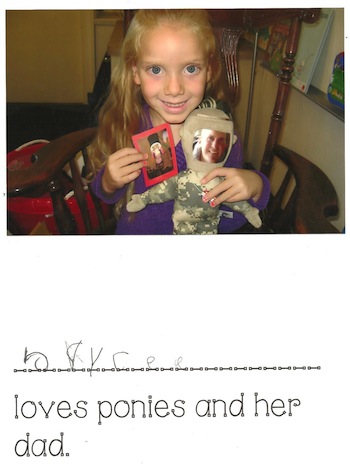 One student’s father was serving in Afghanistan and she brought an army camo doll with a face of a photograph of her father. When students saw this item in her bag, they guessed it belonged to a boy. I asked, “Whose bag do you think this belongs to?” Many eager hands rose to share their guess. Gavin said, “It’s Kolby’s.” When I asked why, he said, “Because it is green and brown. Those are boy colors.” To his surprise when I asked the owner of the bag to stand-up, Jaycee, a girl, proudly stood up. She shared with us that the doll was a gift from her dad before he left to war. She said, “Whenever I miss my dad, I hug it.”
One student’s father was serving in Afghanistan and she brought an army camo doll with a face of a photograph of her father. When students saw this item in her bag, they guessed it belonged to a boy. I asked, “Whose bag do you think this belongs to?” Many eager hands rose to share their guess. Gavin said, “It’s Kolby’s.” When I asked why, he said, “Because it is green and brown. Those are boy colors.” To his surprise when I asked the owner of the bag to stand-up, Jaycee, a girl, proudly stood up. She shared with us that the doll was a gift from her dad before he left to war. She said, “Whenever I miss my dad, I hug it.”
Another student brought a photograph of himself and his two mothers. “Mommy Suey and Mommy Shelly took me to Seattle to see the Space Needle,” Brendon explained as he walked around the circle to show-off his photograph. Other students brought such items as: a cross necklace, a figurine of Santa Claus, baseball cards and favorite stuffed animals.
Once all students shared their culture bags, I took photographs of them with their favorite item in their bag. I made a Personal Culture book out of each student’s photographs for students to read in our class library. The students came to new understandings about their own cultures and those of their classmates.
Finally, in November and December we moved into our exploration of personal cultures with the Family Story Book Bag project. Each book bag contained four personal culture books and a journal for families to write/draw about connections they had with the books. Each story explored important topics about family, such as relationships, celebrations, foods, heritage, hobbies, and play. (See a list of books that were used in the book bags at the end of these vignettes.) The purpose of the Family Story Book Bags was to provide a springboard for sharing family stories as a way for children to learn about their own cultures.
Students had a week to enjoy the books in their book bags. I didn’t give families explicit directions about the journal portion of the bags because I didn’t want to limit them to what they could write and/or draw. Once students returned their book bags and journals, I encouraged students to share their favorite book and journal entry with the class.
Landen and his family read Always (Stott & Phlen, 2008). The story is about a mother/son relationship. The boy gets in trouble but in the end, his mother tells him how she will always love him no matter what. Landen drew a picture of his mother and himself. His mother wrote, “This book reminds Landen about his family and how we say we love each other every night or before we go somewhere.”
Mail Harry To The Moon (Harris & Emberley, 2008) was the book Jackson enjoyed with his family. This hilarious story is about a brother who’s learning what it’s like to have a new baby brother in his family. Jackson drew a sketch of himself and his little brother Charlie. When Jackson shared his journal entry with our class I asked him if he could relate to how Harry treated his baby brother. He said, “Yeah, sometimes Charlie bites me and I want to send him to the moon!”
These activities helped students understand that they each are unique and have a culture to celebrate. The children also made deeper discoveries about their classmates because they had shared their personal culture bags and family story book bag. In the process they learned that their personal cultures and family stories are the same and different.
Next fall, I will encourage my new students to get to know each other and build our classroom community through participating in these activities. I will read aloud more books about other cultures to stimulate discussion and an understanding of other cultures around the world.
* * * * * *
Developing an Understanding about Cultures: Janelle Stolp and Lindsay Abbey
We are first grade teachers in a school in Spokane Valley, Washington. At our school there are about 440 students with sixty-three percent of those students qualified for free or reduced lunch. The community ranges from a low to middle-class. Our classrooms are made up of Caucasian, Hispanic, Asian and African American students.
This year we started our focus on international curriculum with an exploration of the students’ understandings of personal culture. Another part of our curriculum plan was to give our students opportunities to enhance their knowledge about other cultures around the world. We planned to do this through experiences with carefully chosen children’s literature. As teachers, we wanted our students to gain awareness for similarities and differences among ourselves and others. One way our literacy community decided to pursue the exploration of personal culture was to engage the children in the Family Story Book Bags project.
Our first grade team worked hard at the beginning of the year to ensure that our students discovered that each one of them is unique in their own way. We did this by reading aloud many books throughout the first few weeks of school, including The Colors of Us, (Katz, 2007), Enemy Pie (Munson, 2000), You Are Special (Lucado, 1997) and Chrysanthemum (Henkes, 2007). After reading these stories we discussed what made each of the students special and they created self-portraits and did some response writing. Every child was able to share these with the class. This was the first part of our unit on personal culture.
We planned for another exploration of personal culture with our Family Story Book Bags project. These book bags contained children’s books to share and enjoy at home. Most of all we wanted to encourage families to tell their own stories. The books included in the book bags explored topics important to families such as relationships, celebrations, foods, heritage, hobbies and play. These topics helped our students learn about their own culture. (See a list of books that were used in the book bags at the end of these vignettes.) Each child had one week to read the books with their family and respond to at least one of the stories in a journal that was provided. Each week, the students that brought their books back were able to join together and share their responses with each other. Below are some responses students wrote after they read the books.
The students enjoyed learning not only about their own families, but about other families as well, and what makes each of us unique. This project was very well received by families. Many of our parents asked if we could do a second round of Family Book Bags during the spring. We felt grateful to be able to get literature into the hands of our families, and provide them with a way to spend time with their children. As a culmination of the project, the students chose their favorite book from the Family Story Book Bags and designed a T-shirt to represent their family connections to the story.
Throughout the year, we involved our families with our study of cultures. Around the holidays in December, we asked families to share their traditions. Each child drew a picture and wrote about a tradition. This gave us insight about our families within our two classrooms.
Around the New Year, we discussed different activities of families to celebrate the upcoming year. We read-aloud Wish (Thong, 2008) to learn about how people in different countries make wishes. The children discovered how other cultures have celebrations through listening to and discussing this book. Many students only knew about the kind of wish they make before they blow out their birthday candle. However, they learned about many other ways to make wishes. Following that read-aloud, we invited our students to write a New Year’s wish for their family and one for the world.
The last part of the curriculum framework (Short, 2007) focuses on inquires into global issues. We decided one way to pursue this part of the framework was to link Children’s Book Day to Earth Day. We read aloud Book Fiesta! (Mora, 2009) to kick off our celebration! To make the connection with Earth Day we studied ways to take care of our Earth through our science unit. The students were particularly interested in recycling. They decided to recycle books from their home libraries to share with class members. Each student who brought a book gave a book talk to the class. After everyone presented their book talks, we placed the books in the center of our circle and drew names to choose a book. The readers discovered that recycling books could make an impact in our world. As a culminating project of our celebration we used ideas from the website El día de los niños/El día de los libros to encourage students to share their favorite books. The children had a difficult time choosing just one favorite story!
We found that teaching for global understanding can be tricky for first graders. First, we needed to build the children’s background prior to reading books centered around global understandings so they could more effectively comprehend the books that had a focus on global settings and issues. We believe that all the ways we shared books about personal and global cultures helped increase their knowledge so they can take their places as global citizens.
* * * * * *
Layers of Learning in Exploring Cultures in First Grade: Meg Baker and Charlotte Streit
We teach first grade in a school in Northern Spokane. As part of the Spokane literacy community, we were eager to explore aspects of culture for the second year. It seemed so simple– learn about cultures! Given that young children love to talk about themselves, their families and their world our task seemed straightforward. It quickly became evident however that there would be many more layers to this onion that we would be peeling away. In our Spokane community meetings we considered how the curriculum framework in “Curriculum that is International” (Short, 2007) could be implemented in our classroom studies about personal and global cultures. In this vignette we will describe a variety of ways we implemented the curriculum from the framework. In particular we will explain the experiences our students had with the Family Story Book Bags project used by other teachers in our literacy community.
We embarked on our journey of cultural exploration in our first grade classrooms utilizing exquisite pieces of global literature. We were confident that these beautiful books would allow our first graders to connect to the abstract concepts of cultural identity in an enjoyably authentic way.
Our journey of Cultural Exploration
Our students explored the concept of culture in a range of ways. One day, the class gathered around the meeting area to hear a story about making, being and having friends, Meg opened a new book, The Skin You Live In (Tyler, 2005). The story ends with these words:
And like flowers in the fields that make wonderful views
when we stand side-by-side in our wonderful hues,
we all make a beauty so wonderfully true.
We are special and different and just the same, too. (n.p.)
In our discussion of the story the students remarked on the differences in each other’s skin, hair and eye color. Then they discussed the idea that we have so many feelings in common. They were able to more deeply understand their own similarities and differences.
In Charlotte’s classroom the students enjoyed listening to the delightful story of picture pals across the ocean, Same, Same, But Different (Kostecki-Shaw, 2001). As the story unfolded, the children took great delight in chiming in with the repeated phrase “same, same, but different” and were surprised when on the last page there was twist of the phrase:
We’re best friends . . .
even though we live in two different worlds.
Or do we?
Different, different, but the same. (n.p.)
Many times over the next weeks, when reading other variations on this theme, the children would chant the now familiar phrases with glee.
In our literacy community we decided to help the children explore the ways in which culture begins within the family through the Family Story Book Bags project. With the help of Marilyn Carpenter’s extensive collection of global literature as well as our own classroom libraries, we created five book bags for each class. Each book bag contained fiction and non-fiction selections on themes important to families such as grandparents, bedtime, everyday life, hobbies, and food. (See a list of books that were used in the book bags at the end of these vignettes.) The book bags also contained a journal for parents and students to record with pictures and words how their family story connected to the book. The responses were as varied as the families who created them. Some students realized their family experiences were similar to those they were reading about in the books. Others were given an opportunity to hear stories about their own family that they hadn’t heard before. In all cases, parents and children had a literary experience that opened the doors to discussion of family stories and traditions.
Jake’s & Cody’s Journal
Mikaela’s Journal
First graders love to celebrate and we took every opportunity to combine our celebrations with literacy activities. To commemorate International Children’s Book Day the students dressed up as their favorite book character and shared with the class their character and the book from which it came.
To expand our exploration of culture beyond our own front doors we read books with a global focus. Meg introduced the books Whoever You Are (Fox, 1997) and Frozen Land (Reynolds 2007), while Charlotte read aloud Our World of Water (Hollyer, 2009). Through words and pictures in the books we read aloud, the students learned of life in places vastly different from their own. To allow the students the opportunity to delve a little deeper into life in a country of their choice, we launched the Paper Dolls around the World project. Each child chose a country that was interesting or connected to his or her family culture in some way. At home, families worked together to create a decorated paper doll and conduct research addressing basic questions about the country they chose. The dolls and reports were shared in class, hung in the hallway around a world map and made into a class book that students could reference and enjoy.
With background knowledge accessed through reading and responding to global literature, both classes launched a focused study of the land and culture of Mexico. Beautiful fiction and non-fiction books formed the core of our study. Students used a wide variety of non-fiction resources to research self-selected topics related to plants, animals and land features of the primary geographical regions of Mexico. Meg and Charlotte used these mentor texts as models of writing and text features to teach students how to locate pertinent information, paraphrase that information in notes and present that information in their own books. The completed books highlighted each student’s new knowledge of the topic as well as their understanding of text features. They presented their information in pictures, charts, captions, diagrams, and expository text. The most gratifying aspect of the project was the level of engagement demonstrated by the students as they researched and wrote their books; a clear testament of the power of choice and quality books in enriching the learning of young children.
The culmination of the Mexico unit included a sharing of the student written books as well as the artifacts made by students, including Mayan Masks, Aztec Clay Suns, and Paper Bag Piñatas all on display in our Mexican Museum. The Piñata Maker (Ancona, 1994) provided a glimpse into this traditional art form that was engaging for children and informative.
As our yearlong exploration of culture came to a close, the layers of learning kept unfolding. The culmination of our study of culture featured a display and sharing of the student authored books and reports on tri-fold display boards and artistic artifacts that the students had created. Students shared with each other what they learned and discovered about Mexico and global cultures in general. The learning was multi-layered and will continue to expand as students read and experience more. We have noticed that our students need even more exposure to books set in other countries. As one student in Meg’s class said, “I’ve been to the three countries, too; Holland, Hawaii and Seattle!” Clearly, next year there will need to be more books, more explorations, more learning about different countries and places in our own country. We are eager to share the journey with our students.
References
Ancona, G. (1994). The piñata maker/El pinatero. New York: Harcourt.
Bottner, B. (2010). Miss Brooks loves books! (and I don’t). New York: Knopf.
Bunting, E. (2006). One green apple. New York: Clarion.
Bernard, E. & D. (1996). A ride on my mother’s back: A day of baby carrying around the world. New York: Harcourt.
Crummel, S.S. & Stevens, J. (2004). Plaidypus lost. New York: Holiday House.
Donofrio, B.& McClintock B (2007). Mary and the mouse and the mouse and Mary. New York: Schwartz & Wade.
Ehlert, L. (2004). Hands: Growing up to be an artist. New York: Harcourt.
Fimbres, G. (2011). The curricula of sharing family stories. Magazine of the University of Arizona Alumni Association. Fall. 15.
Fox, M. (1997). Whoever you are. New York: Harcourt.
Harris, R.H. & Emberley, M. (2008). Mail Harry to the moon. New York: Little Brown.
Henkes, K. (1991). Chrysanthemum. New York: Greenwillow
Hollyer, B. (2009). Our world of water. New York: Henry Holt.
Katz, K. (2007). The colors of us. New York: Henry Holt.
Kostecki-Shaw, J. (2011). Same, same but different. New York: Henry Holt.
Lindbergh, R. (2005). The visit. New York: Dial.
Lucado, M. (1997). You are special. New York: Scholastic.
Lyon, G.E. (2011). All the water in the world. New York: Atheneum.
Mora, P. (2009). Book Fiesta! New York: HarperCollins.
Mora, P. (2011). El dia de los niños/El dia de los libros. “All About Dia.” Retrieved from http://dia.ala.org
Morris, A. (1993) Bread, bread, bread. New York: HarperCollins.
Munson, D. (2000). Enemy Pie. San Francisco, CA: Chronicle.
Perkins, L.R. (1997). Clouds for dinner. New York: Greenwillow.
Phillipps, J. C. (2009). Wink: The ninja who wanted to be noticed. New York: Viking.
Reynolds, J. (2007). Frozen land. New York: Lee and Low.
Rylant, C. (2002). Let’s go home. New York: Aladdin.
Short, K. (2007). “Exploring a curriculum that is international.” WOW stories: Vol.I Issue 2,
Retrieved from http://wowlit.org/on-line-publications/stories/storiesi2/
Stott, A. & Phlean, M. (2008). Always. Somerville, MA: Candlewick.
Strauss, R. (2007). One well: The story of water on earth. Toronto, On: Kids Can Press.
Thong, R. (2008). Wish. San Francisco, CA: Chronicle.
Tyler, M. (2005). The skin you live in. Chicago Children’s Museum.
Waddell, M. (1989). Once there were giants. Somerville, MA: Candlewick.
Williams, V. (1984). A chair for my mother. New York: HarperCollins.
Williams, V. (1988). Music, music for everyone. New York: HarperCollins.
Wong, J. (2007). The dumpster diver. Somerville, MA: Candlewick.
Wong, J. (2004). Alex and the Wednesday chess club. New York: Margaret McElderry.
Click here to download the list of books used for the Family Story Book Bags.
Lindsay Abbey earned her Master’s degree in Literacy from Eastern Washington University in 2010. She has been teaching first grade for six years in Spokane Valley, Washington.
Meg Baker is a first grade teacher in the Mead School District in Spokane, Washington. In her 25th year of teaching, Meg has discovered that all children love quality literature!
Marilyn Carpenter is Professor Emeritus from Eastern Washington University, where she taught literacy courses, children’s and young adult literature as well as a course on global children’s literature
Lacey Grummons teaches all-day Kindergarten in Spokane, Washington. She has her BA in Elementary Education with a Reading Endorsement and a Master’s in Education with a focus on literacy from Eastern Washington University.
Janelle Stolp has been teaching for 31 years. She earned her Master’s degree in Reading from Eastern Washington Universit. She teaches first grade in Spokane Valley, Washington and is an adjunct instructor at Whitworth University.
Charlotte Streit is currently teaching first grade at Farwell Elementary in Spokane Washington. She also teaches Reading in the Content Areas at Eastern Washington University.
WOW Stories, Volume IV, Issue 4 by Worlds of Words is licensed under a Creative Commons Attribution-NonCommercial-ShareAlike 4.0 International License.
Based on a work at https://wowlit.org/on-line-publications/stories/iv4/.


